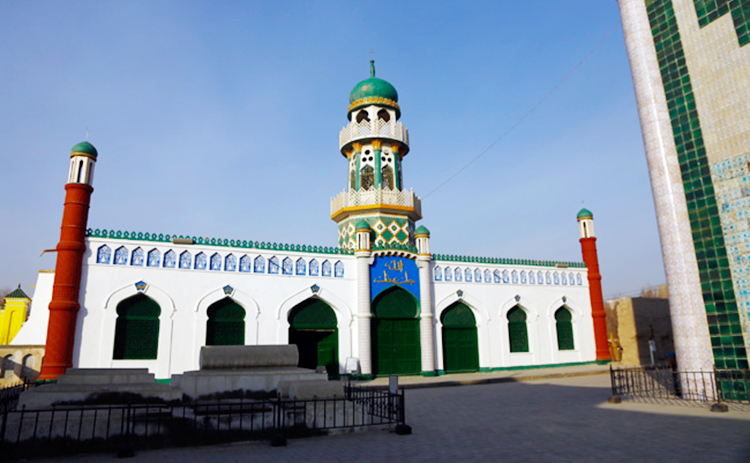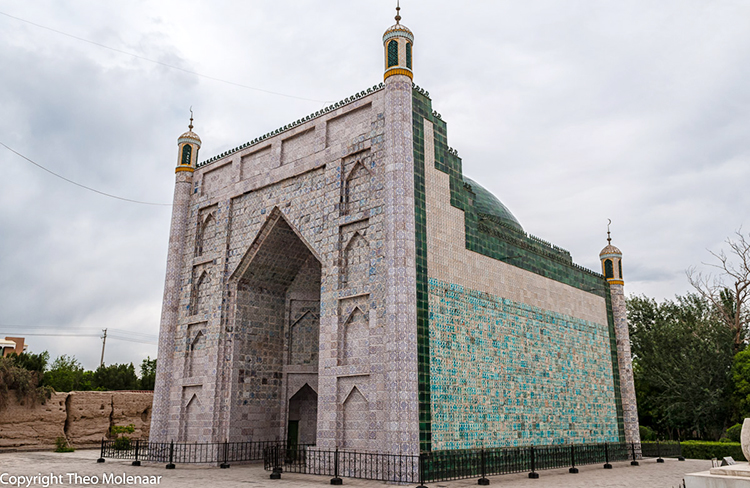Written by: Xiang Jing
Posted on: January 28, 2016 | 
Mausoleums of Hami Uyghur Royal Family
The “Uyghur Prince,” also called the “Hui King”, was the title of the feudal lord of the Hami area, granted by the government of the Qing Dynasty (1644-1911). In 1697, in return for dispatching troops to help the Qing government put down the rebellion of Geerdan, a mongol Khan in Northwest China, Erbeidula, the local Uyghur leader of Hami, was honored with the title of "First Rank Jasagh Darkhan" by Emperor Kangxi of the Qing Dynasty. The troops led by Erbeidula were organized into the Red Banner of the Qing Army and the noble titles from Duke, Beizi (a noble rank title higher than Duke), and Belle (a noble rank title second to that of prince) to Prince were granted to the leader and his descendants. Yusupu, the fourth-generation descendant of Erbeidula, was granted the title of Third-rank Prince and Bosir, the seventh-generation descendant of Erbeidula, was granted the title of Hosho Prince after his death. During the time of the Qing Dynasty, Islam was called "Huijiao" (the religion of the Hui peoples), and Xinjiang was known “Huijiang” (the frontier region inhabited by the “Hui” peoples); its present name was not used till the late 18th century. The Uighur King of Hami area was called the “Hui King”. The Hami Hui Kings ruled the all area of present Shanshan and Hami except Barkol.
Emperor Kangxi of the Qing Dynasty granted Erbeidula the title of First Rank Darkhan in 1697, and in the year 1813, his seventh-generation successor, Bosir, was granted the hereditary title of “Prince of Hami Uyghurs”. This title was annulled in 1930 after the death of Samohosot, the ninth Hami Uyghur Prince. In 233 years, the hereditary title of the Hami Uyghur Prince was granted by right of inheritance to nine generations, from Erbeidula to Samohosot.
Why were the Hami Uyghur princes trusted by the Qing government?Why were Erbeidula and his descendants promoted from the first rank of Darhan to the rank of Prince?Why were the Hami Uyghur princes respected by the local Uyghur and Han peoples?It is believed that the answers mainly lie in their great contributions in support of the Qing government for safeguarding the national unity and preventing schisms and internal disorder. That is why they were always trusted by the Qing government and were esteemed by the people of all ethnic groups of Xinjiang.

From Erbeidula to Prince Samohosot, the Hami Uyghur leaders supported the Qing government's policies of defending the frontier areas by stationing troops and opening up the wasteland. They served the country by sending troops and military supplies to help the central government in defeating the Junggar rebellions and the rebellions of Xinjiang Khwajas. They also helped in fighting against the invasion of Yakubbae of Kokand Khanate and recovering the land occupied by his troops. Praise bestowed on the Uyghur Kings' great feats was recorded in The Draft of Qing History, where the great contributions of the Hami Uyghur leaders were recorded.
Only three Princes of the Hami Uyghur noble family from 1813 to 1930 were buried in the Mausoleums. And it is not surprising that it is the burial site of the members of the Erbeidula family from the seventh generation to the ninth generation.
The Mausoleums of the Uyghur Noble Family in Hami occupy an area of 1.3 hectares and is divided into three sectors. The first sector is a big tomb of the seventh Uyghur Prince Bosir and the eighth Uyghur King Muhammad and 40 other members of the family.
The second sector, located to the south of Bosir's tomb, is a small wooden tomb with a pavilion-type structure. It is said that there were five small tombs in the past, but only two of them are well preserved. One is the tomb of the last Uyghur Prince Samohosot, and he had it built for himself during his lifetime. The other one was built on a pedestal. Looking from outside, Samohosot's tomb is seen to have been built on a square base. On the top is a roof with octagonal upturned eaves, featuring the pavilion style of Inland China. With the upturned eaves and ridge roll, the pavilion roof, supported by pillars, envelops the tomb like a baldachin. Upon entering the tomb site, Islamic-style architecture is seen with a domed top built of adobe and the white walls painted with floral patterns of blue auspicious clouds. Samohosot and 13 of his family members were buried in this tomb.

The other tomb was built on an adobe pedestal. Supported by pillars, a helmet-type wooden roof with double eaves envelops the tomb. Some 12 important officials were buried here. On the basis of an Islamic vault, the two tombs have a style which combines that of Inland-China, the pavilion roof with octagonal upturned eaves, and that of Mongolia, featuring the helmet-like roof. The style of the two-tomb architecture embodies the multi-ethnic and multicultural exchanges here in ancient Hami and it is unique among the style of architecture of Islamic mausoleums.
The third sector is the Id-Kah Mosque. Upon entering the mosque, one can see that 104 red pillars support the huge flat roof. Diamond-type patterns are carved into these pillars, with the pattern of a swastika on the top. The colorful ceiling boasts a caisson pattern and windows; the white walls feature verses from the Koran. The Mi’dhanah building lies outside and the patio is surrounded by beautiful grass and flowers. The structure of the mosque was designed to be very compact and to create a solemn atmosphere. The flat top, which looks magnificent, is also a unique characteristic that distinguishes the architecture of this mosque from others.
The Id Kah Mosque can hold 5,000 persons for prayer. During the Id al-Fitr Festival every year, Muslims coming from all over Hami and other cities and towns, gather here and pray with great piety.
The largest building in the center of the Mausoleum is the tomb of Prince Bosir. It is 17.8 meters high, 20 meters long from east to west and 15 meters wide from north to south. Built on a rectangular base, the tomb is enveloped by a huge vault that is supported by the walls. The exterior of the vault is covered with green glazed bricks, and at the top lies a gourd shaped sign hanging with a crescent moon. The outside of the walls are decorated with green and white glazed bricks, featuring beautiful patterns of auspicious clouds. The shape of the base, the round arched top and the colors of the blue and green glazed bricks, combine to give the tomb a solemn and respectful look. There are lofty pillars on the four corners of the tomb. The pointed arch faces the west and the pillars on both side of the arch are hollow. It has a spiral flight of stairs with 36 steps leading to the top of the tomb, and the white walls inside are painted with blue floral patterns of clouds. Around the top is a flat roof. Stepping on it, one can see the vast expanse of open ground and gardens and villages. Entering the tomb site, one finds that the style is simple but elegant.
You may also like: